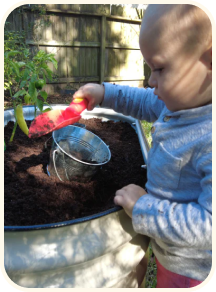Selecting The Right Fertilizer for Your Vegetables, Fruits, and Flowers
We often hear that one-size-fits-all approaches don’t work very well when it comes to education, healthcare, leadership, and any other number of important endeavors. Well, we have something to add to that list: fertilizing your garden.
The phosphorus-rich fertilizers that help our flowers bloom aren’t necessarily great for growing leafy vegetables like spinach or kale. And the fertilizing approach that works for berries isn’t ideal for your annuals. As gardeners, we need to take the time to learn which fertilizers will be best for the plants we’re growing.
Worth the effort
Fertilizing is high on the list of things that you, as a gardener, can do to ensure thriving plants, beautiful flowers, and bountiful harvests.
When we provide essential nutrients like nitrogen, phosphorus, and potassium, we’re giving our plants what they need to grow healthy roots, stems, and leaves. Fertilizers boost fruit and flower production, enhance plants’ immunity, and improve soil structure so it does a better job holding water and providing the oxygen that plant roots need.
But, because we have different goals for our plants (growing lush blooms, producing plenty of tomatoes, developing green leaves), we need to give them nutrients that will help plants achieve them. Not only can providing the wrong fertilizer work against your goals in the garden, but it can also impede plants’ health. For one thing, it can cause nutrient overload, just as bad as undernourishing your plants. Too much nitrogen, for example, can give you lush foliage instead of flowers and fruits — or it could burn your plants’ plant roots, putting their lives at risk.
What about complete fertilizers?
It’s easy to find fertilizers that sound like they’re good for just about everything. A complete fertilizer contains the three key nutrients most plants need: nitrogen (N), phosphorus (P), and potassium (K). These macronutrients appear on fertilizer packaging as NPK. Nitrogen promotes leafy, green growth; phosphorus encourages root development, flowering, and fruiting; and potassium strengthens stems, promotes overall plant health, and helps plants fight disease. Complete fertilizers can have a variety of NPK ratios, like 10-20-10 or 12-24-12, depending on the intended use and specific plant requirements.
While complete fertilizers are a good choice for many applications, they won’t necessarily meet the specific nutrient requirements of certain crops or flowers, especially those that need a tailored nutrient balance. It’s still important to understand what the plants in your garden need.
A few other fertilizer terms you should know include:
All-purpose fertilizer: Often used interchangeably with complete fertilizer, this term generally suggests a product designed to be suitable for a wide range of plants and conditions. But the actual nutrient balance in an all-purpose fertilizer can vary, and it may not always be "complete" if it lacks one of the primary nutrients in a significant amount.
Balanced fertilizer: This specifically refers to fertilizers that have roughly equal amounts of NPK, like 10-10-10 or 20-20-20 ratio. This is a subset of complete fertilizers designed to provide a balanced nutrient supply.
Fertilizer for your veggies
Even within plant categories like vegetables and flowers, you’ll find groups with differing needs. Let’s start with your veggies.
Leafy greens: If you’re growing kale, lettuce, or spinach, they’ll need a healthy serving of nitrogen to develop. Phosphorus and potassium won’t be priorities because these plants won’t be working to develop fruits or edible roots. Another thing to keep in mind: Because leafy greens are quick growers, they benefit from regular, light feedings. That gives them a steady supply of nitrogen without over-fertilization.
Root vegetables: Veggies in this category, including beets, carrots, potatoes, and radishes, do best with all-purpose fertilizer that will create nutrient-rich soil (soil amendments like compost will be very important, too.) Look for something that also includes micronutrients like iron, manganese, and zinc. If you’re growing carrots or radishes, avoiding over-fertilization will be especially important because it can cause forked roots or excessive foliage with small roots.
Tomatoes: These plants can benefit from calcium-enriched fertilizer, which will prevent blossom end rot and support fruit development, and magnesium, which helps in chlorophyll production and improves fruit quality.
As for NPK, their needs will change as they develop. One effective strategy would be to start your tomatoes with a balanced NPK ratio during their seeding/early growth phase. Then, switch to a formulation that promotes fruiting, one that’s lower in nitrogen and higher in phosphorus and potassium. That should give you healthy plants and a good yield of tomatoes.
Broccoli, cauliflower, corn, squash: To promote growth for these large plants, and plenty of flowering, provide high-nitrogen fertilizer, which will support robust leaf and stem growth. With cauliflower and broccoli, after the initial high-nitrogen application to boost leaf growth, switch to a balanced fertilizer to encourage better head formation. For squash, an additional feeding when the fruit sets will help promote better yields.
Fertilizing your fruit
Are you interested in growing berries or melons in your gardens? They have unique needs, too.
Berries: Berries generally need a well-balanced fertilizer to support all stages of growth. For example:
- Blackberries thrive with nitrogen-rich fertilizers early in the season.
- Blueberries need acid-forming fertilizers like ammonium sulfate to thrive in their preferred acidic soil conditions.
- Strawberries benefit from early applications of balanced fertilizers, with a boost of potassium mid-season for fruit quality and size.
Melons: Melons like watermelons and cantaloupes need an initial nitrogen boost for vine growth, followed by phosphorus and potassium-rich fertilizers to support fruit development.
Additional micronutrients like magnesium and boron will enhance fruit setting and quality.
Fertilizer for your flowers
While all flowers need fertilizer that will help them, well, flower, your strategy will vary for annuals (flowers that grow, flower, set seed, and die within a year) and perennials (which return for several years).
Annuals: Generally, these flowers need a fertilizer that supports rapid growth and abundant flowering. They’ll benefit from something that has a higher proportion of nitrogen and phosphorus since they promote strong vegetative growth and vibrant blooms.
Perennials: They’ll need fertilizer that will support both the bloom and the health of their root system over many seasons. Look for a balanced fertilizer with equal parts nitrogen, phosphorus, and potassium, which supports roots, shoots, and flowers.
Below, we’ve included a list of popular flowers and tips on selecting fertilizers for them.
Roses: These flowers are heavy feeders and benefit from fertilizers rich in nitrogen, phosphorus, and potassium. Use a balanced rose-specific fertilizer or a combination of compost and a slow-release granular fertilizer designed for flowering plants.
Tulips: They’ll do well with fertilizers that have a higher amount of potassium to support strong bulb development and vibrant blooms. Bone meal or bulb-specific fertilizers are excellent choices.
Marigolds: These flowers are not very demanding, but they respond well to fertilizers that enhance flowering. A balanced all-purpose garden fertilizer works well.
Petunias: These flowers need regular feeding to sustain their blooms. Use a balanced, water-soluble fertilizer.
Sunflowers: They do well with a balanced nutrient supply; they need plenty of phosphorus for their large blooms.




















